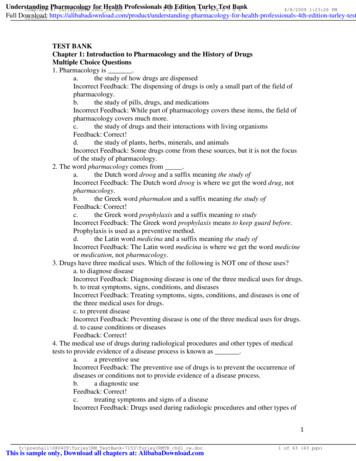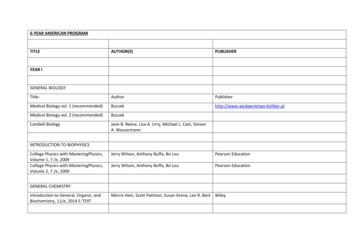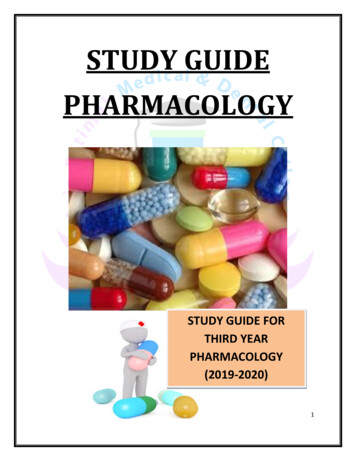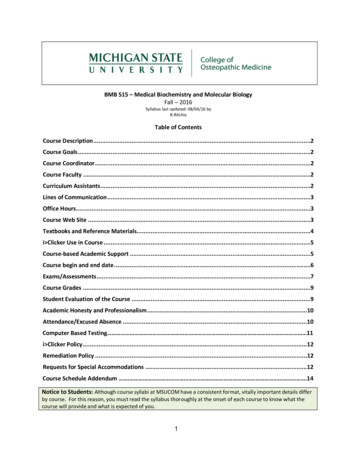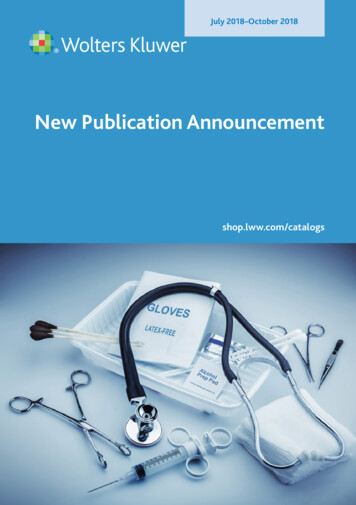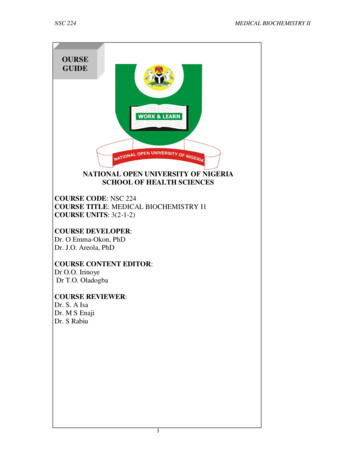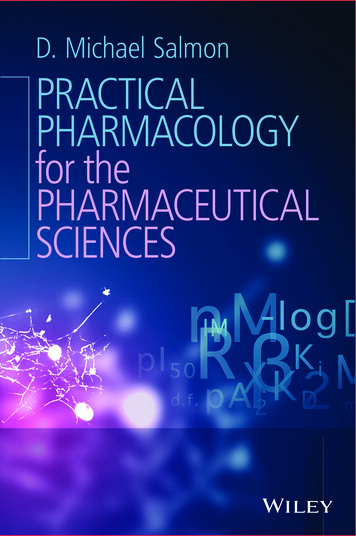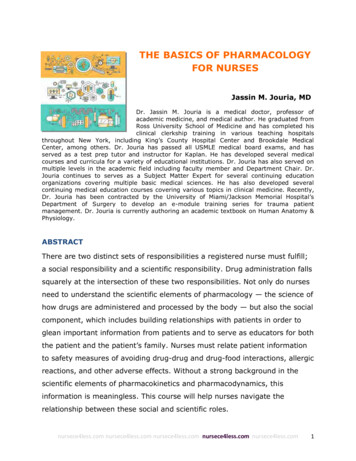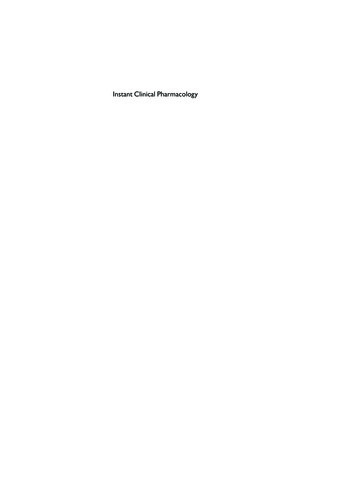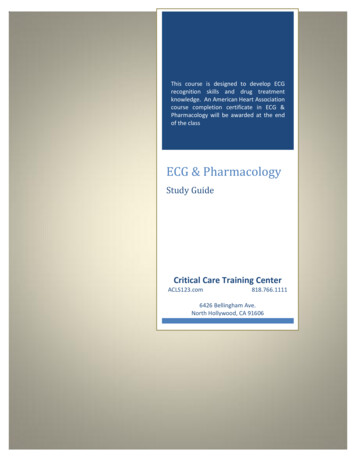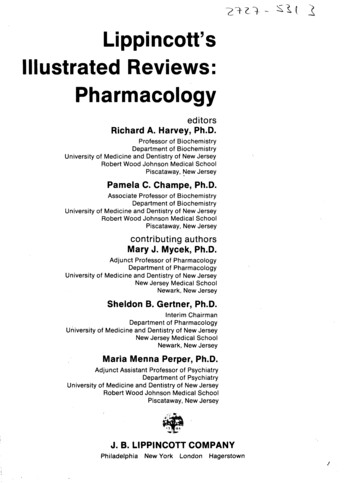
Transcription
Lippincott'sIllustrated Reviews:PharmacologyeditorsRichard A. Harvey, Ph.D.Professor of BiochemistryDepartment of BiochemistryUniversity of Medicine and Dentistry of New JerseyRobert Wood Johnson Medical SchoolPiscataway, New JerseyPamela C. Champe, Ph.D.Associate Professor of BiochemistryDepartment of BiochemistryUniversity of Medicine and Dentistry of New JerseyRobert Wood Johnson Medical SchoolPiscataway, New Jerseycontributing authorsMary J. Mycek, Ph.D.Adjunct Professor of PharmacologyDepartment of PharmacologyUniversity of Medicine and Dentistry of New JerseyNew Jersey Medical SchoolNewark, New JerseySheldon B. Gertner, Ph.D.Interim ChairmanDepartment of PharmacologyUniversity of Medicine and Dentistry of New JerseyNew Jersey Medical SchoolNewark, New JerseyMaria Menna Perper, Ph.D.Adjunct Assistant Professor of PsychiatryDepartment of PsychiatryUniversity of Medicine and Dentistry of New JerseyRobert Wood Johnson Medical SchoolPiscataway, New JerseyJ. B. LIPPINCOTT COMPANYPhiladelphia New York LondonHagerstown
Brief ContentsUNIT I: Introduction to PharmacologyChapter 1: Absorption, Distribution, and Elimination of DrugsChapter 2: Pharmacokinetics and Drug Receptors 151UNIT II: Drugs Affecting the Autonomic Nervous SystemChapterChapterChapterChapterChapter3: The Autonomic Nervous System4: Cholinergic Agonists 355: Cholinergic Antagonists 456: Adrenergic Agonists 557: Adrenergic Antagonists 7125UNIT III: Drugs Affecting the Central Nervous apterChapter8: Treatment of Parkinson's Disease 839: Anxiolytic and Hypnotic Drugs 9110: CNS Stimulants 10111: Anesthetics 10912: Antidepressant Drugs 11913: Neuroleptic Drugs 12714: Opioid Analgesics and Antagonists 13315: Drugs Used to Treat Epilepsy 143UNIT IV: Drugs Affecting the Cardiovascular : The Treatment of Congestive Heart Failure17: Antiarrhythmic Drugs 16118: Antianginal Drugs 17119: Antihypertensive Drugs 17520: Drugs Affecting Blood 18521: Antihyperlipidemic Drugs 199151UNIT V: Drugs Affecting Other Organ 2: Drugs Affecting the Respiratory System 20723: Diuretic Drugs 21124: Gastrointestinal Drugs 22325: Hormones of the Pituitary and Thyroid 22926: Insulin and Oral Hypoglycemic Drugs 23527: Steroid Hormones 243UNIT VI: Chemotherapeutic DrugsChapterChapterChapterChapterChapter28: Principles of Antimicrobial Therapy 25929: Folate Antagonists 26530: Inhibitors of Cell Wall Synthesis 27331: Protein Synthesis Inhibitors 28532: Quinolones, Urinary Tract, and AntitubercularAgents 297IX
Brief ContentsChapterChapterChapterChapterChapter33: Antifungal Drugs 30734: Antiprotozoal Drugs 31335: Anthelmintic Drugs 32536: Antiviral Drugs 32937: Anticancer Drugs 337UNIT VII: Anti-Inflammatory Drugs and AutacoidsChapter 38: Anti-inflammatory Drugs 361Chapter 39: Autacoids and Autacoid AntagonistsGlossary 397Answers to Study QuestionsIndex 441403379
Expanded ContentsUNIT I: Introduction to PharmacologyChapter 1: Absorption, Distribution, and Elimination of DrugsI. Overview 1II. Routes of Drug Administration 1III. Absorption of Drugs 3IV. Bioavailability 4V. Drug Distribution 6VI. Volume of Distribution 7VII. Binding of Drugs to Plasma Proteins 10VIII. Drug Metabolism 11Chapter 2: Pharmacokinetics and Drug Receptors 15I. Overview 15II. Kinetics of Intravenous Infusion 15III. Kinetics of Fixed-Dose, Fixed-Time Interval RegimensIV. Dose-Response Quantitation 18V. Therapeutic Index 20VI. Drug Elimination 21117UNIT II: Drugs Affecting the Autonomic Nervous SystemChapter 3: The Autonomic Nervous SystemI. Overview 25II. Introduction to the Nervous System 25III. Chemical Signaling Between Cells 29IV. Second Messenger Systems 3125Chapter 4: Cholinergic Agonists 35I. Overview 35II. The Cholinergic Neuron 35III. Direct-acting Cholinergic Agonists 39IV. Anticholinesterases (Reversible) 41V. Anticholinesterases (Irreversible) 42Chapter 5: Cholinergic Antagonists 45I. Overview 45II. Antimuscarinic Agents 45III. Ganglionic Blockers 48IV. Neuromuscular Blocking Drugs 49Chapter 6: Adrenergic Agonists 55I. Overview 55II. The Adrenergic Neuron 55III. Characteristics of Adrenergic Agonists 59IV. Direct-acting Adrenergic Agonists 61V. Indirect-acting Adrenergic Agonists 67VI. Mixed-action Adrenergic Agonists 68XI,
JKMExpanded ContentsChapter 7: Adrenergic Antagonists 71I. Overview 71II. a-Adrenergic Blocking Agents 71III. j8-Adrenergic Blocking Agents 74IV. Drugs Affecting Neurotransmitter Release or Uptake79UNIT III: Drugs Affecting the Central Nervous SystemChapter 8: Treatment of Parkinson's Disease 83I. Overview of the Central Nervous System 83II. Neurotransmission in the CNS 83III. Synaptic Potentials 84IV. Overview of Parkinson's Disease 85V. Drugs Used in Parkinson's Disease 86Chapter 9: Anxiolytic and Hypnotic Drugs 91I. Overview 91II. Benzodiazepines 91III. Other Anxiolytic Agents 95IV. Barbiturates 96V. Nonbarbiturate Sedatives 98Chapter 10: CNS Stimulants 101I. Overview 101II. Psychomotor Stimulants 101III. Convulsants and Respiratory StimulantsIV. Hallucinogens 107107Chapter 11: Anesthetics 109I. Overview 109II. Depth of Anesthesia 109III. Kinetics of Anesthesia 110IV. Molecular Mechanism of Anesthesia 111V. General Anesthetics: Inhaled 112VI. General Anesthetics: Intravenous 114VII. Combination Anesthetics 115VIII. Local Anesthetics 116IX. Preanesthetic Medications 116X. Muscle Relaxants 117Chapter 12: Antidepressant Drugs 119I. Overview 119II. Tricyclic/Polycyclic Antidepressants 119III. Serotonin-Uptake Inhibitors 122IV. Monoamine Oxidase Inhibitors 123V. Lithium Salts 125Chapter 13: Neuroleptic DrugsI. Overview 127II. Schizophrenia 127III. Neuroleptic Drugs 127127Chapter 14: Opioid Analgesics and AntagonistsI. Overview 133II. Opioid Receptors 133133
Expanded ContentsxiiiIII. Strong Agonists 134IV. Moderate Agonists 139V. Mixed Agonist-antagonists 140VI. Antagonists 140VII. Opioid Peptides (Opiopeptins) 141Chapter 15: Drugs Used to Treat EpilepsyI. Overview of Epilepsy 143II. Antiepileptic Drugs 145143UNIT IV: Drugs Affecting the Cardiovascular SystemChapter 16: Treatment of Congestive Heart FailureI. Overview of Congestive Heart Failure 151II. Physiology of Muscle Contraction 151III. Cardiac Glycosides 155IV. Alternative Therapies in Heart Failure 158151Chapter 17: Antiarrhythmic Drugs 161I. Overview 161II. Causes of Arrhythmias 161III. Class I Antiarrhythmic Drugs 162IV. Class II Antiarrhythmic Drugs 167V. Class III Antiarrhythmic Drugs 167VI. Class IV Antiarrhythmic Drugs 168VII. Other Antiarrhythmic Drugs 170Chapter 18: Antianginal Drugs 171I. Overview 171II. Organic Nitrates 171III. Calcium-Channel Blockers 172IV. /8-Adrenergic Blockers 174Chapter 19: Antihypertensive Drugs 175I. Overview 175II. Etiology of Hypertension 175III. Mechanisms for Controlling Blood PressureIV. Treatment Strategies 176V. Antihypertensive Drugs 179VI. Hypertensive Emergency 183Chapter 20: Drugs Affecting Blood 185I. Overview 185II. Normal Response to Vascular TraumaIII. Platelet Activation 186IV. Blood Coagulation 188V. Platelet Aggregation Inhibitors 188VI. Anticoagulants 189VII. Thrombolytic Drugs 192VIII. Drugs Used to Treat Bleeding 195IX. Agents Used to Treat Anemia 196175185Chapter 21: Antihyperlipidemic Drugs 199I. Overview 199II. Hyperlipidemias 199III. Drugs that Lower Serum Lipoprotein Concentration202
xivExpanded ContentsUNIT V: Drugs Affecting Other Organ SystemsChapter 22: Drugs Affecting the Respiratory SystemI. Overview 207II. Drugs Used to Treat Asthma 207III. Drugs Used to Treat Rhinitis 209IV. Drugs Used to Treat Cough 210207Chapter 23: Diuretic Drugs 211I. Overview 211II. Regulation of Fluid and Electrolytes by the KidneysIII. Carbonic Anhydrase Inhibitors 214IV. Loop or High-Ceiling Diuretics 215V. Thiazides and Related Agents 217VI. Potassium-sparing Diuretics 219VII. Osmotic Diuretics 221211Chapter 24: Gastrointestinal Drugs 223I. Overview 223II. Drugs Used to Treat Peptic Ulcers 223III. Laxatives 227Chapter 25: Hormones of the Pituitary and ThyroidI. Overview 229II. Hypothalamic and Pituitary Hormones 229III. Thyroid Hormones 231229Chapter 26: Insulin and Oral Hypoglycemic Drugs 235I. Overview 235II. Metabolic Roles of Insulin and Glucagon 235III. Diabetes Mellitus 235IV. Insulin 237V. Insulin Preparations 238VI. Oral Hypoglycemic Agents: Sulfonylureas 240Chapter 27: Steroid Hormones 243I. Overview 243II. Estrogens 243III. Progestins 246IV. Oral Contraceptives 248V. Androgens 250VI. Adrenal Corticosteroids 252UNIT VI: Chemotherapeutic DrugsChapter 28: Principles of Antimicrobial Therapy 259I. Overview 259II. Selection of Antimicrobial Agents 259III. Bacteriostatic Versus Bactericidal Drugs 261IV. Chemotherapeutic Spectra 261V. Combinations of Antimicrobial Drugs 262VI. Drug Resistance 262VII. Prophylactic Antibiotics 263VIII. Complications of Antibiotic Therapy 263
Expanded ContentsChapter 29: Folate AntagonistsI. Overview 265II. Sulfonamides 265III. Trimethoprim 267IV. Co-Trimoxazole 269xv265Chapter 30: Inhibitors of Cell Wall SynthesisI. Overview 273II. Penicillins 273III. Cephalosporins 279IV. Other /8-Lactam Antibiotics 281V. j8-Lactamase Inhibitors 282VI. Other Agents Affecting the Cell Wall 283Chapter 31: Protein Synthesis InhibitorsI. Overview 285II. Tetracyclines 285III. Aminoglycosides 288IV. Erythromycin 290V. Chloramphenicol 292VI. Clindamycin 293VII. Spectinomycin 294273285Chapter 32: Quinolones, Urinary Tract, and AntitubercularAgents 297I. Overview 297II. Quinolones 297III. Urinary Tract Antiseptics 300III. Chemotherapy of Tuberculosis 301IV. Chemotherapy of Leprosy 305Chapter 33: Antifungal Drugs 307I. Overview 307II. Drugs for Subcutaneous and Systemic MycoticInfections 307III. Drugs for Superficial Mycotic Infections 311Chapter 34: Antiprotozoal Drugs 313I. Overview 313II. Chemotherapy of Amebiasis 313III. Chemotherapy of Leishmaniasis 316IV. Chemotherapy of Trypanosomiasis 317V. Chemotherapy of Toxoplasmosis 320VI. Chemotherapy of Malaria 320Chapter 35: Anthelmintic Drugs 325I. Overview 325II. Drugs for the Treatment of Nematodes 325III. Drugs for the Treatment of Trematodes 326IV. Drugs for the Treatment of Cestodes 327Chapter 36: Antiviral Drugs 329I. Overview 329II. Treatment of Respiratory Viruses 329III. Treatment of Herpes Virus Infections 331
xviExpanded ContentsIV. Treatment for Acquired Immunodeficiency Syndrome(AIDS) 334Chapter 37: Anticancer Drugs 337I. Overview 337II. Principles of Cancer Chemotherapy 337III. Antimetabolites 341IV. Antibiotics 346V. Alkylating Agents 349VI. Mitotic Spindle Poisons 351VII. Hormones 353VIII. Other Chemotherapeutic Agents 355UNIT VII: Anti-inflammatory Drugs and AutacoidsChapter 38: Anti-inflammatory Drugs 361I. Overview 361II. Prostaglandins 361III. NSAIDs 363IV. Non-narcotic Analgesics 371V. Slow-acting, Anti-inflammatory Agents 373VI. Drugs Employed in the Treatment of Gout 374Chapter 39: Autacoids and Autacoid AntagonistsI. Overview 379II. Prostaglandins 379III. Angiotensins 380IV. Angiotensin Antagonists 381V. The Kinins: Bradykinin and Kallidin 384VI. Serotonin and Its Antagonists 384VII. Ergot Alkaloids 387VIM. Overview of Histamine 388IX. Blockers of Histamine Hi Receptors 390X. Blockers of Histamine H2 Receptors 393Glossary 397Answers to Study QuestionsIndex 441403379
Lippincott's Illustrated Reviews: Pharmacology editors Richard A. Harvey, Ph.D. Professor of Biochemistry Department of Biochemistry University of Medicine and Dentistry of New Jersey Robert Wood Johnson Medical School Piscataway, New Jersey Pamela C. Champe, Ph.D. Associate Professor of Biochemistry Department of Biochemistry
